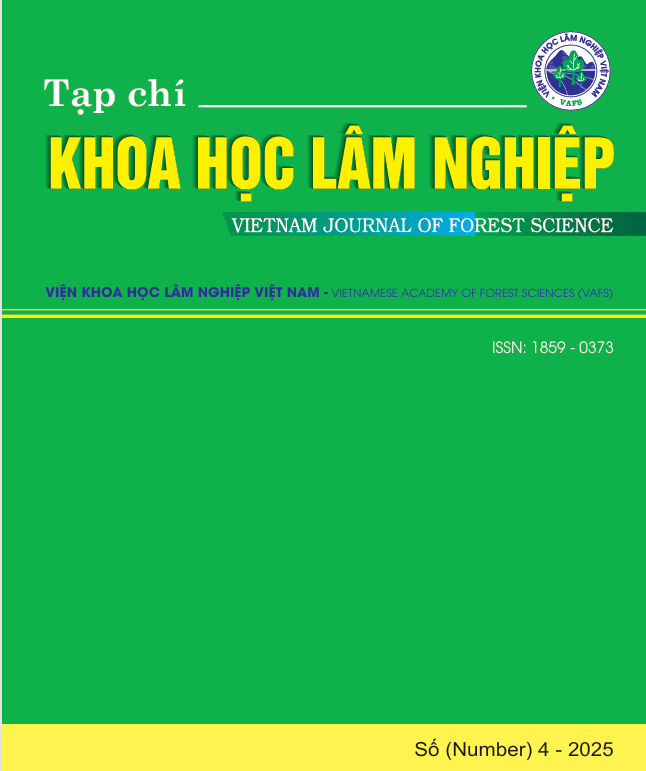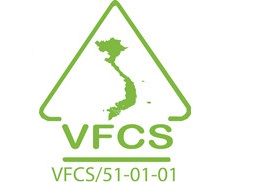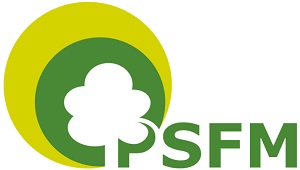ẢNH HƯỞNG CỦA ĐIỀU KIỆN XỬ LÝ NHIỆT DẦU ĐẾN MỘT SỐ TÍNH CHẤT CƠ LÝ CỦA GỖ KEO LAI
DOI:
https://doi.org/10.70169/VJFS.1093Từ khóa:
Acacia mangium × Acacia auriculiformis, biến tính nhiệt dầu, đặc tính cơ lý, dầu thực vật tái chế, nhựa dầu tự nhiênTóm tắt
Nghiên cứu này phân tích ảnh hưởng của điều kiện xử lý đến độ ẩm thăng bằng (EMC), hiệu suất chống hút nước (WRE), hiệu suất chống trương nở (ASE), và độ bền uốn tĩnh (MOR) của gỗ keo lai (Acacia mangium × Acacia auriculiformis) sau khi biến tính nhiệt với hỗn hợp nhựa dầu tự nhiên và dầu thực vật tái chế. Nhựa dầu tự nhiên, một loại lâm sản ngoài gỗ thu được từ cây Dầu rái (Dipterocarpus alatus Roxb.), và dầu thực vật tái chế từ cơ sở tái chế dầu được phối trộn theo tỷ lệ khối lượng 20:80, sử dụng làm môi trường truyền nhiệt trong khoảng nhiệt độ từ 150 °C đến 190 °C, thời gian xử lý kéo dài từ 60 đến 90 phút. Phân tích theo phương pháp đáp ứng bề mặt cho thấy mô hình hồi quy bậc hai xây dựng được có hệ số tương quan cao, phản ánh mức độ phù hợp tốt với dữ liệu thực nghiệm. Kết quả cho thấy EMC giảm từ 9,8% đến 45,5% so với mẫu đối chứng khi nhiệt độ xử lý tăng dần. WRE và ASE tăng đáng kể khi nâng cao nhiệt độ và kéo dài thời gian xử lý, đạt giá trị cực đại lần lượt là 28,37% và 48,03%. Trong khi đó, MOR giảm nhẹ trong khoảng từ 1% đến 9,7% so với mẫu chưa xử lý. Những kết quả này cho thấy xử lý nhiệt bằng hỗn hợp nhựa dầu tự nhiên và dầu thực vật tái chế giúp cải thiện đáng kể khả năng ổn định kích thước, đồng thời chỉ gây ảnh hưởng nhẹ đến khả năng chịu uốn của gỗ keo lai.
Tài liệu tham khảo
1. Acosta-Acosta R., Montoya-Arango J.A., Joma-da-Silva E., 2021. Technologies Applied to Wood Heat Treatments, a Review. Scientia et Technica 26 (2): 127 - 136. https://doi.org/10.22517/23447214.22641.
2. ASTM International, 2020. ASTM D4442-20: Standard Test Methods for Direct Moisture Content Measurement of Wood and Wood-Based Materials. ASTM International, Pennsylvania.
3. ASTM International, 2023. ASTM D143-23: Standard Test Methods for Small Clear Specimens of Timber. ASTM International, Pennsylvania.
4. Bhuiyan T. and Hirai N., 2005. Study of crystalline behaviour of heat-treated wood cellulose during treatments in water. Journal of Wood Science 51:42-47. https://doi.org/10.1007/s10086-003-0615-x.
5. Boonstra M.J. and Tjeerdsma B., 2006. Chemical analysis of heat treated softwoods. European Journal of Wood and Wood Products 64: 204 - 211. https://doi.org/10.1007/s00107-005-0078-4.
6. Çiftçi D, Altay Ç, 2024. Determination of some physical properties of oil heat treated oriental beech wood. Düzce Univ J For 20 (1):361-374. https://doi.org/10.58816/duzceod.1415260.
7. Đào Hùng Cường, 2004. Nghiên cứu đánh giá khả năng chống thấm của Dầu rái. Tạp chí Khoa học và Công nghệ, Đại học Đà Nẵng.
8. Esteves BM, Graca J, Pereira HM, 2008. Extractive composition and summative chemical analysis of thermally treated eucalypt wood. Holzforschung 62:344-351. https://doi.org/10.1515/HF.2008.057.
9. Haseli M., Efhamisisi D., Abdulkhani A., Oladi R., Ungerer B., Al-musawi H., Halmschlager E., Müller U., 2024. Effects of oil heat treatment on poplar wood properties: A pilot scale study. Construction and Building Materials 430: 136353. https://doi.org/10.1016/j.conbuildmat.2024.136353.
10. He L., Zhang T., Xie W., Zhao X., Wang Z., He Z., Yi S., 2025. Improving structural integrity and dynamics of lignocellulosic polymers in heat-treated wood with tung oil. International Journal of Biological Macromolecules 305: 140949. https://doi.org/10.1016/j.ijbiomac.2025.140949.
11. Jimenez J.J.P. and Ramos J.E.C., 2024. Dimensional stability and mechanical strength of thermally modified giant bamboo [Dendrocalamus asper (Schult.) Backer] using steam and oil. Adv Bamboo Sci 7: 100081. https://doi.org/10.1016/j.bamboo.2024.100081.
12. Kapçak M.A., Toker H., Özdemi̇r E., Baysal E. and Altay C., 2024. Some Physical and Mechanical Characteristics of Waste Olive Oil Heat-Treated Oriental Beech Wood. Wood Industry/Drvna Industrija 75 (2): 207 - 214. https://doi.org/10.5552/drvind.2024.0134.
13. Kaya A.I., 2023. Combined effects of linseed oil and heat treatment on the properties of cypress and maple wood Part 1: Water absorption, mechanical properties, and sound absorption capacity. BioResources 18 (2): 2940 - 2963. https://doi.org/10.15376/biores.18.2.2940-2963.
14. Lee S.H., Ashaari Z., Lum W.C., Halip J.A., Ang A.F., Tan L.P., Chin K.L. and Tahir P.M., 2018. Thermal treatment of wood using vegetable oils: A review. Construction and Building Materials 181: 408 - 419. https://doi.org/10.1016/j.conbuildmat.2018.06.058.
15. Luu H.T. and Pinto F., 2007. Dipterocarp oleoresin in Vietnam and Cambodia: Harvesting techniques, resource management and livelihood issues: A report from an exchange visit to Cambodia. Center for Biodiversity and Development (CBD), Ho Chi Minh City.
16. Manalo R.D. and Garcia C.M., 2012. Termite resistance of thermally-modified Dendrocalamus asper (Schultes f.) Backer ex Heyne. Insects 3 (2): 390 - 395. https://doi.org/10.3390/insects3020390.
17. Mandraveli E., Mitani A., Terzopoulou P. and Koutsianitis D., 2024. Oil heat treatment of wood—A comprehensive analysis of physical, chemical, and mechanical modifications. Materials 17: 2394. https://doi.org/10.3390/ma17102394.
18. Molnár A., Horváth N. and Taschner R., 2012. The effect of dry heat treatment on physical properties of Acacia mangium and Acacia auriculiformis from Vietnam. In: The 5th Conference on Hardwood Research and Utilisation in Europe 2012. Nyugat-magyarországi Egyetem Kiadó, Sopron, pp. 370-382.
19. Nguyễn Thị Minh Nguyệt và Vũ Mạnh Tường, 2016. Ảnh hưởng của xử lý nhiệt đến một số tính chất cơ học gỗ keo lai. Tạp chí Khoa học Lâm nghiệp (1): 4285 - 4291.
20. Nguyễn Trung Hiếu và Trần Văn Chứ, 2013. Ảnh hưởng của xử lý nhiệt đến tính chất cơ học của gỗ Keo tai tượng trồng tại Hà Giang. Tạp chí Khoa học và Công nghệ Lâm nghiệp (2): 95 - 104.
21. Oyeleye I.O., Olaniran S.O., Owoyemi J.M. and Oluwasina O.O., 2024. Physical and mechanical properties of selected Nigerian wood species after thermo-oil modification. Ligno 20 (2): 77 - 87.
22. Tăng Thị Kim Hồng và Nguyễn Nhật Quang, 2025a. Effects of natural oleoresin heat treatment on the improvement of some physical and mechanical properties of loblolly pine wood (Pinus taeda). IOP Conference Series: Earth and Environmental Science 1465: 012011. https://doi.org/10.1088/1755-1315/1465/1/012011.
23. Tăng Thị Kim Hồng và Nguyễn Nhật Quang, 2025b. Optimization of natural oleoresin and waste cooking oil heat treatment conditions for rubberwood using response surface methodology. Journal of the Indian Academy of Wood Science. https://doi.org/10.1007/s13196-025-00378-1.
24. Tăng Thị Kim Hồng, Trịnh Hiền Mai và Nguyễn Thị Thanh Hiền, 2022. Mould resistance of the bamboo Thyrsostachys siamensis treated with oleoresin heat. Journal of Forestry Science and Technology (13): 103 - 108. https://doi.org/10.55250/jo.vnuf.2022.13.103-108.
25. Tăng Thị Kim Hồng và Nguyễn Nhật Quang, 2021. Effect of oleoresin heat treatment on mechanical and physical properties of the bamboo Thyrsostachys siamensis. Journal of Forestry Science and Technology (12): 106 - 115.
26. TCVN, 2021. TCVN 13352:2021: Gỗ biến tính – Phương pháp thử cơ lý. Tổng cục Tiêu chuẩn Đo lường Chất lượng, Hà Nội, Việt Nam.
27. Tjeerdsma B.F. and Militz H., 2005. Chemical changes in hydrothermal treated wood: FTIR analysis of combined hydrothermal and dry heat-treated wood. European Journal of Wood and Wood Products 63: 102 - 111. https://doi.org/10.1007/s00107-004-0532-8.
28. Trần Văn Chứ, 2013. Improvement of Dimensional Stability of Acacia mangium Wood by Heat Treatment: A Case Study of Vietnam. Journal of Forest Science 29 (2): 109 - 115. http://dx.doi.org/10.7747/JFS.2013.29.2.109.
29. Trịnh Hiền Mai, Nguyễn Thị Yên và Nguyễn Thị Thắm, 2018. Ảnh hưởng của chế độ xử lý nhiệt đến một số chỉ tiêu tính chất vật lý của gỗ Keo tai tượng (Acacia mangium Willd). Tạp chí Khoa học và Công nghệ Lâm nghiệp (4): 160 - 166.
30. Umar I., Zaidon A., Lee S.H. and Halis R., 2016. Oil-heat treatment of rubberwood for optimum changes in chemical constituents and decay resistance. Journal of Tropical Forest Science 28: 88 - 96.
31. Wahab R., Sulaiman O., Khalid I., Rasat M.S.M. and Sudin M., 2013. Chemical, Colour and Strength Changes of Eco-friendly Hot Oil Treatment on 15 Year-old Cultivated Acacia Hybrid. International Journal on Advanced Science, Engineering and Information Technology 3 (1): 6 - 15. https://doi.org/10.18517/ijaseit.3.1.268.













